Western Digital SE16 750GB: "Quiet" a Performer
by Dave Robinet on August 9, 2007 2:00 AM EST- Posted in
- Storage
iPEAK Video/Audio Tests
The iPEAK based Video/Audio benchmarks are designed around simulating media encoding and HTPC activities. These benchmarks are CPU intensive in nature but also require a balanced storage system with the ability to handle read and write requests simultaneously in a very efficient manner. Using iPEAK also effectively removes the CPU from the equation, allowing us to focus on the hard drives.
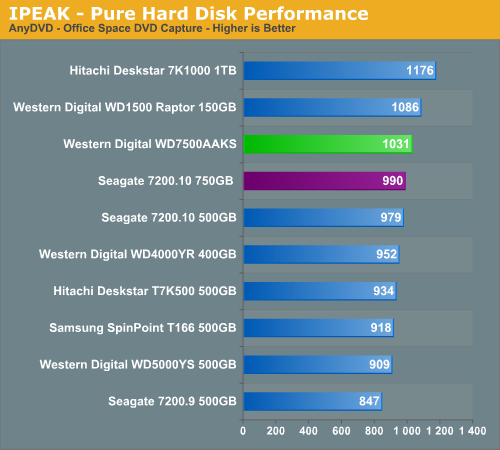
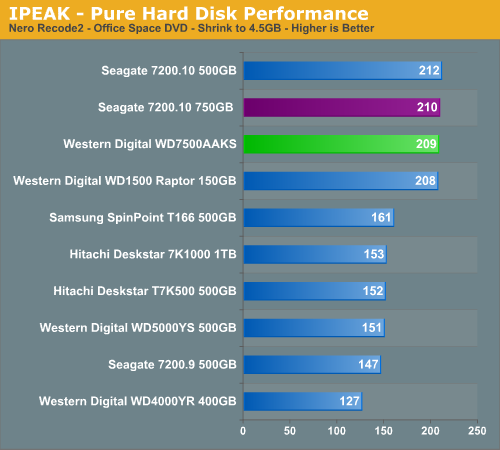
The AnyDVD benchmark is heavily weighted to sequential write requests with the PMR based drives generally finishing ahead of the other 7200RPM drives. The Western Digital drive beats the Seagate 7200.10 in this benchmark by nearly 4%, and even comes close to the vaunted Raptor. All non-PMR drives in the benchmark fall further behind the WD7500AAKS, generally moving well into the double-digit percentage differences. (Higher data density means faster transfer rates, which is part of the reason the PMR drives do so well.)
The Nero Recode 2 benchmark is weighted to streaming read requests but is balanced by continuous write operations near the end of the test. In this assessment, the Seagate 7200.10 edges out the WD7500AAKS slightly, which in turn comes in slightly ahead of the WD Raptor. Other non-PMR disks fall far behind in this benchmark. Realistically, the three drives at the top of this chart can be considered equal in this kind of task given the modest numerical difference in scores between each drive.
iPEAK Game Installation Tests
Our iPEAK based Game Installation benchmarks simply show the ability of the hard drive to write data as quickly as possible to the disc based upon the installation software instructions. As detailed in our iPEAK setup description we installed the games from our source drive in order to eliminate the optical drive bottleneck. In separate application timing we witnessed basically the same percentage spread when installing the games via our DVD drive so these results are representative of actual installation performance.
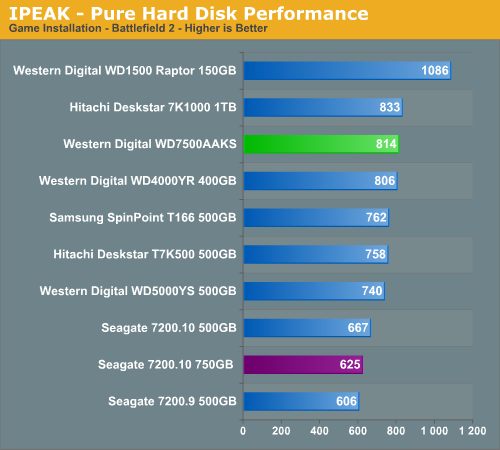
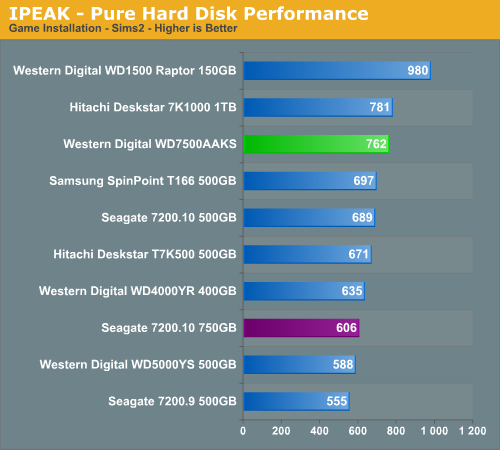
The Raptors, as expected, dominates our gaming tests due to their rotational and random access speed advantages. The WD7500AAKS turns in third-place finishes in both of these tests, behind the speedy Hitachi 7K1000 drive and lightning fast Raptors. Of note, the difference in performance between Western Digital's 750GB offering and Seagate's 7200.10 750GB drive is roughly 15% in each case.
iPEAK Game Play Tests
The iPEAK based Game Play tests are centered on the benefits of having a hard disk that can load non-linear or sequential data files quickly without interrupting the flow of the game.
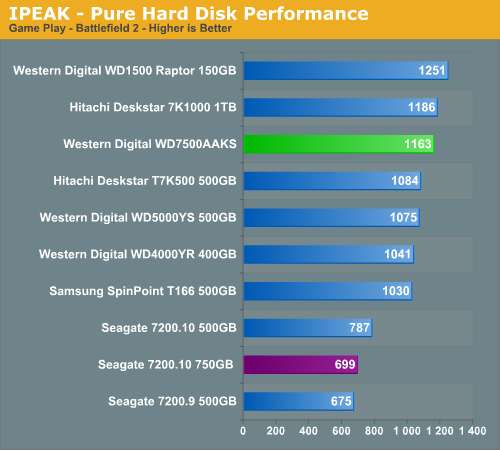
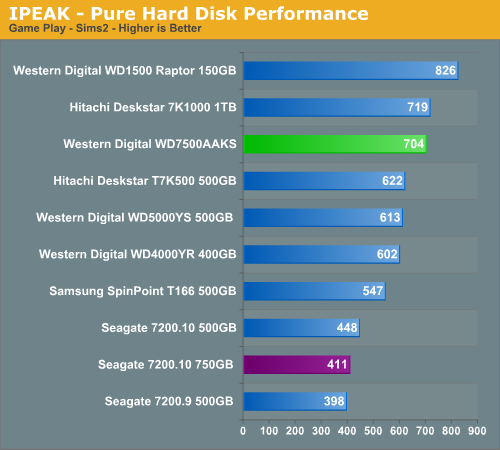
In a virtual copy of the results from the iPEAK Game Installation tests, the Western Digital WD7500AAKS comes in third, behind the Raptor and the Hitachi 7K1000. The difference between the Western Digital drive and the Seagate 750GB drive has become a chasm, benchmarking at a roughly 35% differential.
We need to remember our iPEAK tests reflect pure hard drive performance and will be mitigated by the system platform components as we will see in our application tests.
The iPEAK based Video/Audio benchmarks are designed around simulating media encoding and HTPC activities. These benchmarks are CPU intensive in nature but also require a balanced storage system with the ability to handle read and write requests simultaneously in a very efficient manner. Using iPEAK also effectively removes the CPU from the equation, allowing us to focus on the hard drives.


The AnyDVD benchmark is heavily weighted to sequential write requests with the PMR based drives generally finishing ahead of the other 7200RPM drives. The Western Digital drive beats the Seagate 7200.10 in this benchmark by nearly 4%, and even comes close to the vaunted Raptor. All non-PMR drives in the benchmark fall further behind the WD7500AAKS, generally moving well into the double-digit percentage differences. (Higher data density means faster transfer rates, which is part of the reason the PMR drives do so well.)
The Nero Recode 2 benchmark is weighted to streaming read requests but is balanced by continuous write operations near the end of the test. In this assessment, the Seagate 7200.10 edges out the WD7500AAKS slightly, which in turn comes in slightly ahead of the WD Raptor. Other non-PMR disks fall far behind in this benchmark. Realistically, the three drives at the top of this chart can be considered equal in this kind of task given the modest numerical difference in scores between each drive.
iPEAK Game Installation Tests
Our iPEAK based Game Installation benchmarks simply show the ability of the hard drive to write data as quickly as possible to the disc based upon the installation software instructions. As detailed in our iPEAK setup description we installed the games from our source drive in order to eliminate the optical drive bottleneck. In separate application timing we witnessed basically the same percentage spread when installing the games via our DVD drive so these results are representative of actual installation performance.


The Raptors, as expected, dominates our gaming tests due to their rotational and random access speed advantages. The WD7500AAKS turns in third-place finishes in both of these tests, behind the speedy Hitachi 7K1000 drive and lightning fast Raptors. Of note, the difference in performance between Western Digital's 750GB offering and Seagate's 7200.10 750GB drive is roughly 15% in each case.
iPEAK Game Play Tests
The iPEAK based Game Play tests are centered on the benefits of having a hard disk that can load non-linear or sequential data files quickly without interrupting the flow of the game.


In a virtual copy of the results from the iPEAK Game Installation tests, the Western Digital WD7500AAKS comes in third, behind the Raptor and the Hitachi 7K1000. The difference between the Western Digital drive and the Seagate 750GB drive has become a chasm, benchmarking at a roughly 35% differential.
We need to remember our iPEAK tests reflect pure hard drive performance and will be mitigated by the system platform components as we will see in our application tests.










37 Comments
View All Comments
Dave Robinet - Thursday, August 9, 2007 - link
Actually, the difference is that the EIDE drive only is offered up to a 500GB capacity. This precludes it from having the additional features given to the 750GB drive, as mentioned in the article.If you're only using the single drive under "normal" desktop usage, however, you're not terribly likely to see a big difference in performance between a 500GB SATA and 500GB EIDE, all things being equal.
Thanks for reading!
dave
semo - Thursday, August 9, 2007 - link
i understand the sata vs. pata arguments. it's just the new features and low power draw that interest me and since the model numbers look so similar i thought that they would share the same characteristics.Frumious1 - Thursday, August 9, 2007 - link
Besides the one using a slower, outdated interface? Probably not. Thankfully, the 750GB drive is NOT available in PATA format as far as I can tell. WD's EIDE offerings top out at 500GB on their website. Seriously, who buys a top-end hard drive in EIDE format these days? Hell I only have one IDE connection on my motherboard, and that's no longer in use!semo - Thursday, August 9, 2007 - link
the 750gb version may be a top end part but the 500gb is very reasonably priced. anyway, you can never convince me that a hard drive is "high end", whatever the cost. real world performance does not vary much and depends very much on usage patterns. now an ssd or a revolutionary redesign of hdd i can consider to be high end.Dave Robinet - Thursday, August 9, 2007 - link
Agreed - if you can use SATA, you will. Some people can't, however, and the EIDE interface isn't an incredible bottleneck to the system (like, for example, the move from ISA to PCI graphics cards was in adopting the new bus).You're right, though - there's no reason to intentionally buy EIDE anymore if you have SATA available in your system. :)
Thanks for reading!
dave
Basilisk - Thursday, August 9, 2007 - link
'Won't there be negligible P-ATA demand, with none from manuf's? So, 'probably no P-ATA version, or a hefty premium on it.If my Linux distro supported the S-ATA controller chip, I'd spend the $20-$25 on a PCI or PCI-e S-ATA card and ignore the P-ATA. It would be a shame to have that P-ATA 750GB and later find yourself w/o a m/b having P_ATA to make good use of it! [Okay, you could probably buy a P-ATA controller card....]
wilburpan - Thursday, August 9, 2007 - link
Who buys a large capacity EIDE hard drive? I did recently.Why? I have an old computer that I've repurposed into a file server running Linux. This computer is old enough that it doesn't have SATA connections.